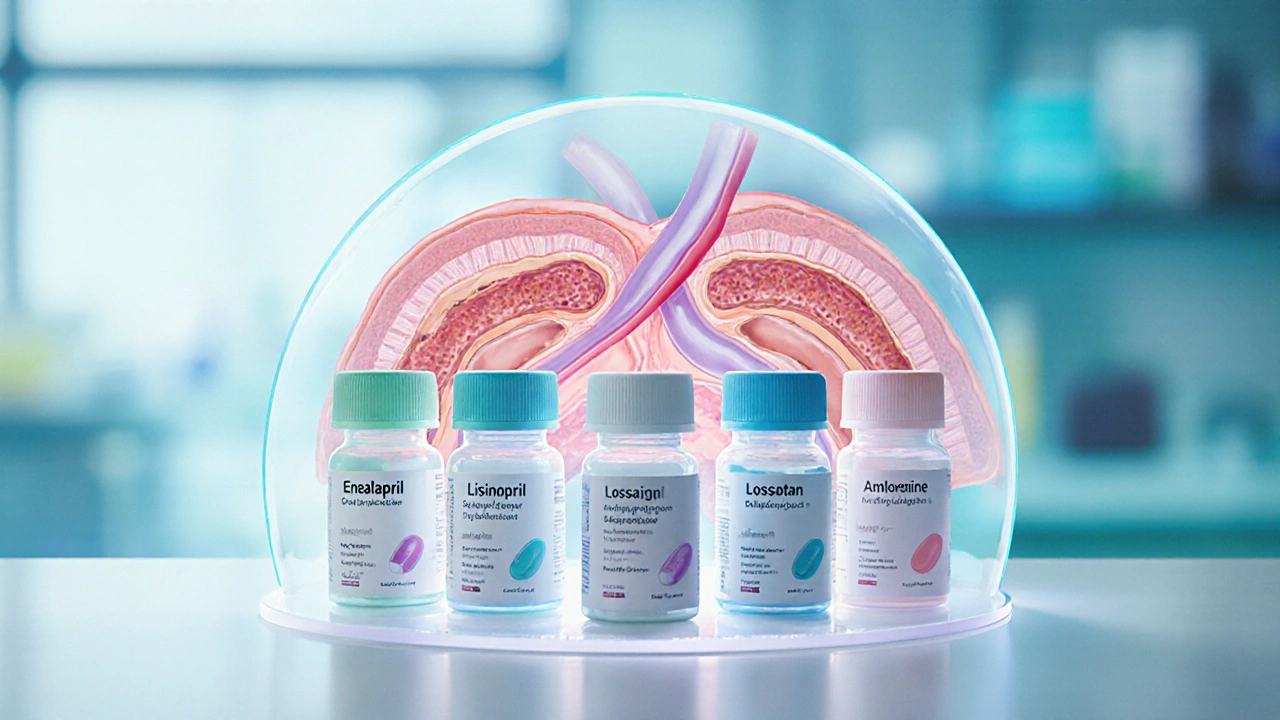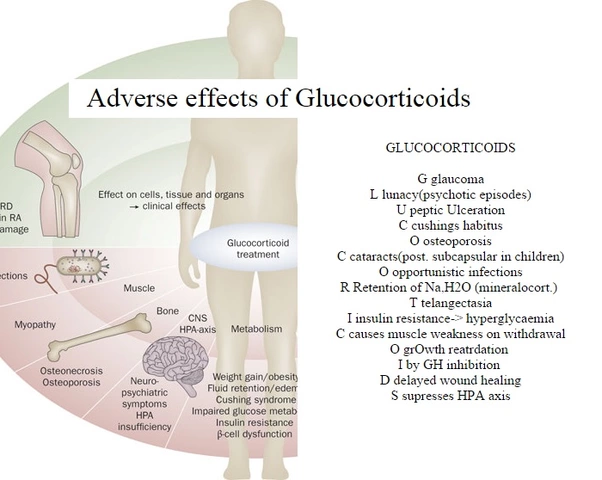
Coversyl (Perindopril Arginine) vs Top Blood Pressure Alternatives - 2025 Comparison
Blood Pressure Medication Selector
Personalized Medication Selection
Answer these questions to get personalized recommendations for blood pressure medications that best suit your needs.
Key Takeaways
- Coversyl (Perindopril Arginine) is a highly effective ACE inhibitor for hypertension and heart failure.
- Its once‑daily dosing and long half‑life give steady blood‑pressure control.
- Common alternatives include other ACE inhibitors (Enalapril, Lisinopril, Ramipril) and ARBs (Losartan, Valsartan).
- Calcium‑channel blocker amlodipine is a non‑ACE option that works well when ACE inhibitors cause cough.
- Choose based on side‑effect profile, kidney function, and any concurrent medications.
When treating hypertension, Coversyl is a brand name for Perindopril Arginine, an ACE inhibitor that relaxes blood vessels and lowers blood pressure. It’s sold in 2mg, 4mg, and 8mg tablets and is taken once a day, usually in the morning. Apart from high blood pressure, doctors also prescribe it for chronic heart failure and to reduce the risk of stroke in patients with vascular disease.
How Coversyl Works and What to Expect
Perindopril blocks the conversion of angiotensin I to angiotensinII, a potent vasoconstrictor. By cutting this pathway, the drug widens arteries, decreases aldosterone release, and ultimately reduces the workload on the heart. Most patients see a 10-15mmHg drop in systolic pressure within two weeks.
Typical side effects are mild: occasional dry cough, dizziness, or a slight increase in potassium. Serious risks-like angio‑edema-are rare but require immediate medical attention.
Top Alternatives to Consider
Below are the most common drugs clinicians compare with Coversyl. Each belongs to a well‑defined class and has distinct pros and cons.
Enalapril - another ACE inhibitor, usually started at 5mg once daily. It’s slightly cheaper but may need twice‑daily dosing for some patients.
Lisinopril - known for its long half‑life, allowing a once‑daily 10-20mg dose. It’s widely prescribed in the U.S. and has a similar cough risk.
Ramipril - often chosen for heart‑failure patients because of documented mortality benefits. Typical dose ranges from 2.5mg to 10mg daily.
Losartan - an angiotensinII receptor blocker (ARB). It avoids the cough issue but can raise potassium levels more than ACE inhibitors.
Valsartan - another ARB, good for patients with chronic kidney disease. Doses start at 80mg twice daily.
Amlodipine - a calcium‑channel blocker that works by relaxing the smooth muscle of arterial walls. It’s especially useful when edema is a concern.

Decision Criteria - What to Weigh When Choosing a Medication
- Side‑effect tolerance: If a dry cough is intolerable, an ARB (Losartan, Valsartan) or a calcium‑channel blocker (Amlodipine) may be preferable.
- Kidney function: ACE inhibitors and ARBs can protect kidneys in diabetic patients, but they require close monitoring of creatinine and potassium.
- Dosing convenience: Once‑daily meds (Coversyl, Lisinopril, Ramipril) improve adherence compared with twice‑daily options.
- Cost and insurance coverage: Generic enalapril or lisinopril are often cheaper than brand‑name Coversyl.
- Comorbid conditions: For heart‑failure patients, ramipril and certain ARBs have proven mortality benefits; for patients with peripheral edema, amlodipine may be added.
Side‑Effect Comparison Table
| Drug | Class | Common Side‑Effects | Serious Risks | Typical Starting Dose |
|---|---|---|---|---|
| Coversyl | ACE inhibitor | Cough, dizziness, mild headache | Angio‑edema, hyperkalemia | 2mg once daily |
| Enalapril | ACE inhibitor | Cough, fatigue | Angio‑edema, renal impairment | 5mg once daily |
| Lisinopril | ACE inhibitor | Cough, taste disturbances | Angio‑edema, elevated potassium | 10mg once daily |
| Ramipril | ACE inhibitor | Cough, dizziness | Angio‑edema, renal issues | 2.5mg once daily |
| Losartan | ARB | Headache, fatigue | Hyperkalemia, rare liver injury | 50mg once daily |
| Valsartan | ARB | Dizziness, cough (less common) | Hyperkalemia, renal dysfunction | 80mg twice daily |
| Amlodipine | Calcium‑channel blocker | Peripheral edema, flushing | Rare severe hypotension | 5mg once daily |
Choosing the Right Drug - A Quick Decision Flow
- Do you have a persistent dry cough on ACE inhibitors? Yes → Consider an ARB (Losartan or Valsartan) or switch to amlodipine.
- Is kidney function compromised (eGFR < 30mL/min)? Yes → Prefer agents with proven renal protection (ACE inhibitors like Ramipril) but monitor closely; avoid high‑dose ARBs.
- Do you need once‑daily dosing for adherence? Yes → Choose Coversyl, Lisinopril, or Ramipril.
- Is cost a major factor? Yes → Generic enalapril or lisinopril may be more affordable.
- Any history of angio‑edema? Yes → Avoid all ACE inhibitors and ARBs; consider amlodipine.

Real‑World Patient Stories
John, 58, recently diagnosed with hypertension, tried Coversyl 4mg daily. Within three weeks his blood pressure fell from 152/96mmHg to 128/78mmHg. He reported a mild, non‑troublesome cough, which faded after four weeks. When his insurance switched to a higher copay, his doctor switched him to generic lisinopril with similar results.
Maria, 65, with type‑2 diabetes, experienced a persistent cough on Enalapril. Her cardiologist moved her to Losartan, which eliminated the cough while maintaining a stable blood pressure of 130/80mmHg. She needed occasional potassium checks because ARBs can raise serum potassium.
David, 72, has chronic heart failure. He was placed on Ramipril 5mg because studies showed reduced mortality in heart‑failure patients. His ejection fraction improved from 35% to 42% over six months.
Frequently Asked Questions
Frequently Asked Questions
Can I take Coversyl with a diuretic?
Yes, many doctors pair Coversyl with thiazide‑type diuretics (e.g., hydrochlorothiazide) to boost blood‑pressure reduction. Monitor potassium and blood‑sodium levels regularly.
How long does it take for Coversyl to show results?
Most patients notice a measurable drop in systolic pressure within 2weeks, but full therapeutic effect may take 4-6weeks.
Is it safe to use Coversyl during pregnancy?
ACE inhibitors, including perindopril, are contraindicated in the second and third trimesters because they can cause fetal kidney damage. Switch to a safer antihypertensive under medical guidance.
What should I do if I miss a dose?
Take the missed tablet as soon as you remember, unless it’s almost time for the next dose. In that case, skip the missed one and continue with your regular schedule. Never double‑dose.
Can I switch from Coversyl to an ARB without a washout period?
Yes, a direct switch is generally safe. However, your doctor may order a brief monitoring period to check potassium and kidney function.
Next Steps for Patients and Caregivers
- Schedule a blood‑pressure check and discuss any side‑effects with your clinician.
- Ask about generic equivalents if cost is a concern; most alternatives have affordable versions.
- Keep a medication list handy, noting dose, timing, and any recent lab results (creatinine, potassium).
- If you experience persistent cough, swelling, or facial rash, contact your healthcare provider immediately.
- Consider lifestyle tweaks-low‑salt diet, regular exercise, and stress management-to maximize drug efficacy.







8 Comments
Barbra Wittman October 13, 2025
Wow, you’ve managed to squeeze an entire pharmacology textbook into a single Reddit post, kudos. First, let’s applaud the earnest attempt to guide strangers through the labyrinth of ACE inhibitors versus ARBs, because who doesn’t love a good spreadsheet of side effects on a Saturday night? The tone drips with the subtle sarcasm of someone who’s read every FDA monograph, yet somehow still thinks a dry cough is a minor inconvenience. Of course, the once‑daily dosing argument is appealing, especially when you consider the tragedy of forgetting a pill after a hectic workday. Meanwhile, the cost‑effectiveness section reads like a bargain‑hunter’s manifesto, reminding us that generic enalapril can be purchased for the price of a latte. I also appreciate the inclusion of patient anecdotes; nothing says “evidence‑based practice” like a three‑paragraph story about John’s blood pressure drop. The decision‑flow chart is a masterpiece of oversimplification, turning complex renal physiology into a choose‑your‑own‑adventure. Let’s not forget the extensive table, which, despite its aesthetic charm, still manages to cram hyperkalemia and renal impairment into a single column. The FAQ section, while thorough, could have mentioned the teratogenic risks earlier, but hey, why bother with consistency? In sum, the article is a commendable blend of clinical detail and marketing fluff, perfect for anyone who enjoys scrolling through a pharmacy catalog while sipping tea. If you’re looking for a quick reference, this post delivers – if you’re seeking nuance, you might want to consult a nephrologist. Finally, remember that adherence is king, but never sacrifice safety for convenience. And as always, keep those blood‑pressure cuffs calibrated, because an inaccurate reading is the real villain here. Cheers to the author for cramming so much into a single page; may your future posts be equally as dense.
Dannii Willis October 19, 2025
I have to say, the layout is quite user‑friendly and the tone manages to stay both professional and approachable. The inclusion of a quick questionnaire is a nice touch for those who want a personalized recommendation without scrolling through pages of text. Also, the side‑effect table is handy for quick reference, especially when comparing ACE inhibitors with ARBs and calcium‑channel blockers.
Robyn Du Plooy October 24, 2025
From a pharmacodynamic standpoint, the article does a solid job contextualising perindopril’s inhibition of the renin‑angiotensin‑aldosterone system (RAAS) and how that translates to downstream vasodilation. I especially liked the brief nod to the fact that ARBs bypass the bradykinin surge, which is why they’re cough‑free alternatives. The jargon‑heavy sections are actually helpful for clinicians who need a quick refresher on ACE‑mediated potassium handling.
Zach Yeager October 30, 2025
These meds work fine for most people but beware of hidden side effects.
Sarah Aderholdt November 5, 2025
Choosing a drug is a balance between efficacy and tolerability; the cough risk with ACE inhibitors often tips the scale toward an ARB for many patients. Cost considerations should never override safety.
Phoebe Chico November 10, 2025
Honestly, the colorful side‑effect chart feels like a pop‑art masterpiece – who knew hypertension could look so vibrant? If you’re into snazzy graphics, this post nails it.
Larry Douglas November 16, 2025
From a clinical perspective, the dosing ranges provided are consistent with the latest ESC guidelines. It’s also worth noting that renal monitoring should be performed at baseline and after dose adjustments. The article could improve by referencing specific trial data for mortality benefit.
Michael Stevens November 22, 2025
Great points, Larry! I’d add that for patients who struggle with daily adherence, pairing an ACE inhibitor with a long‑acting thiazide can improve outcomes without adding complexity.